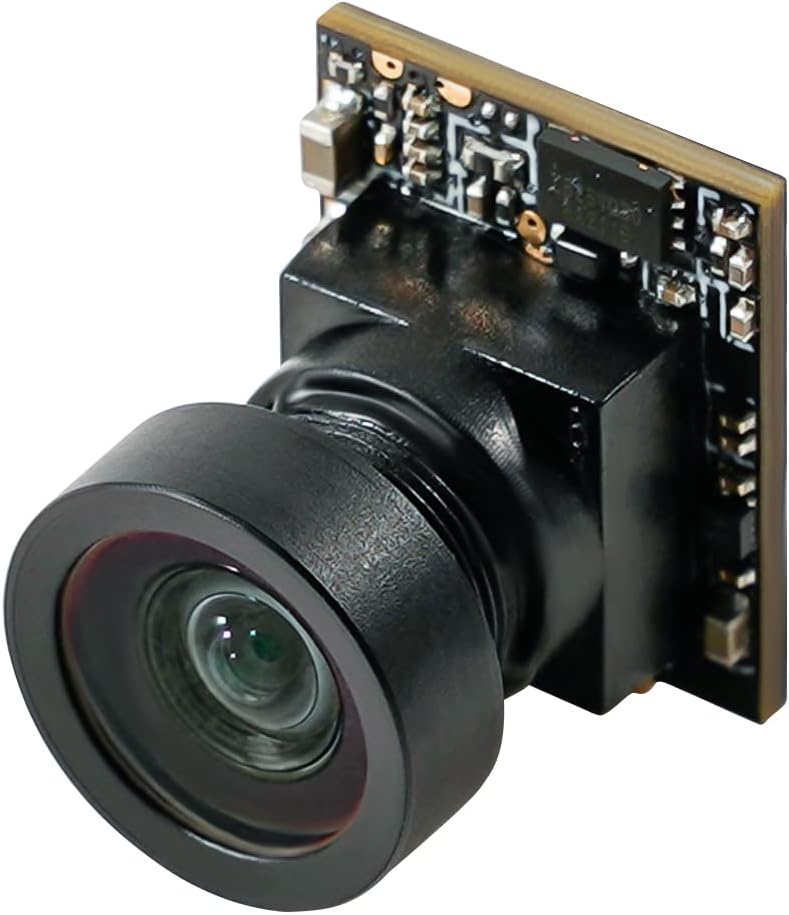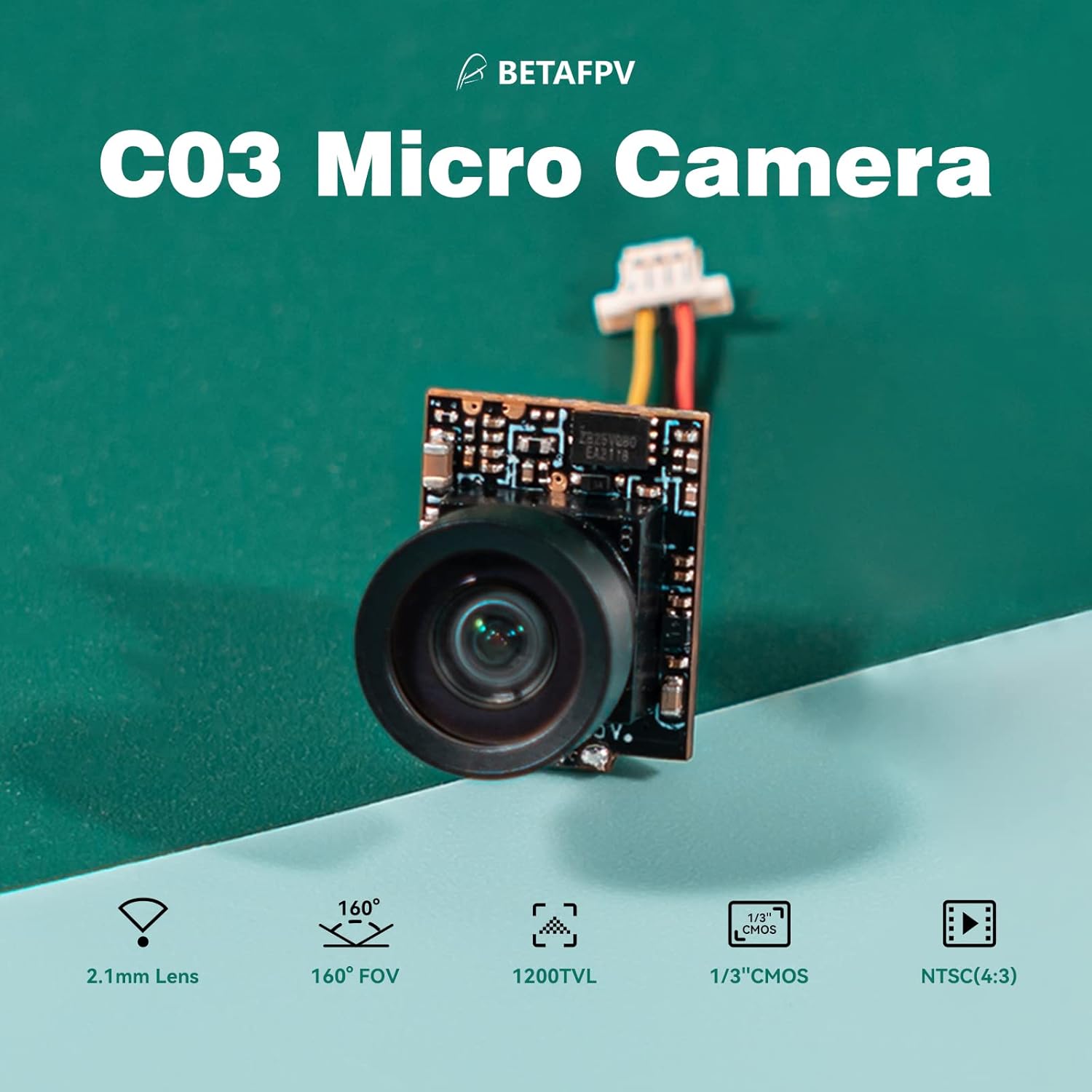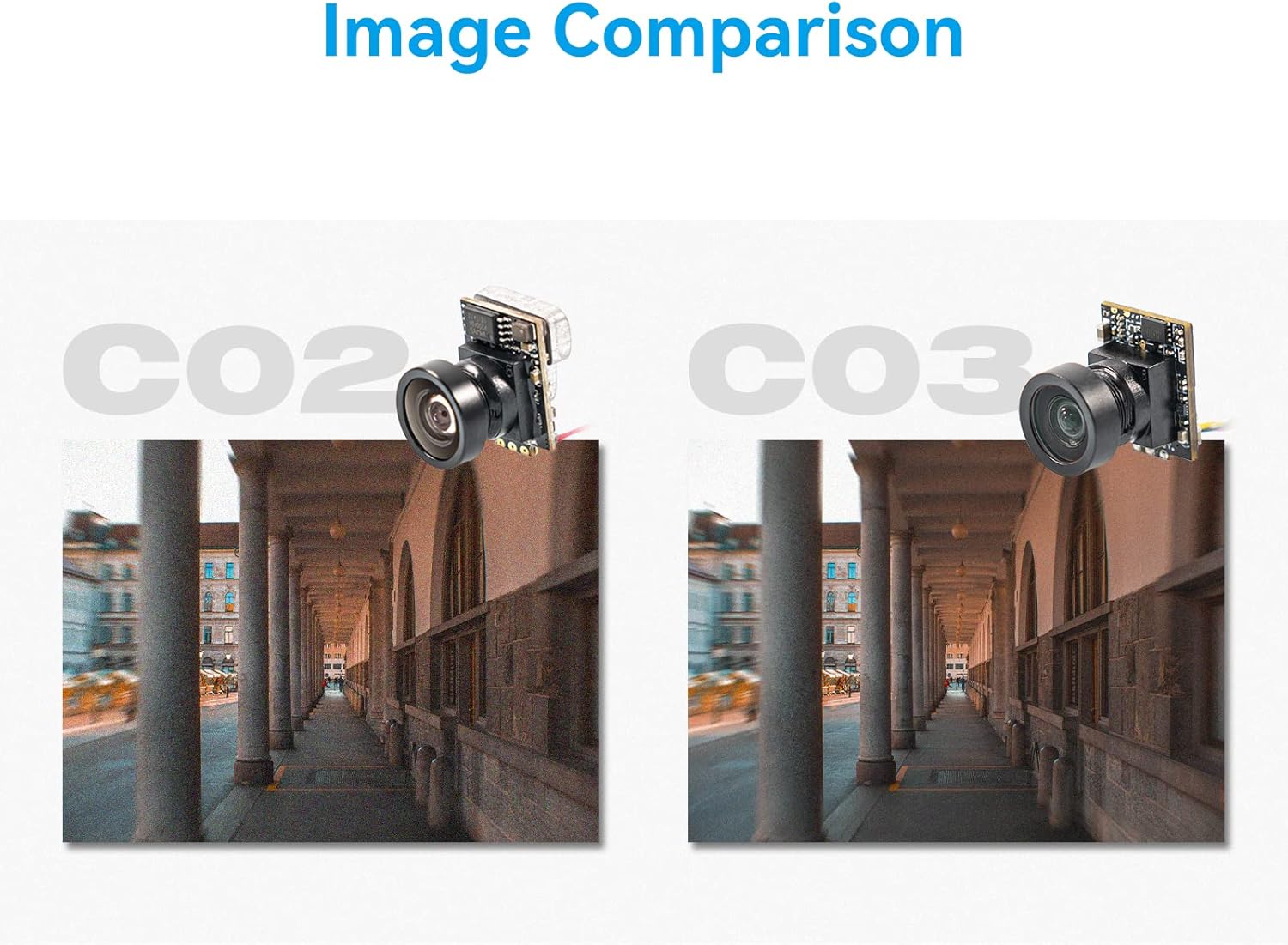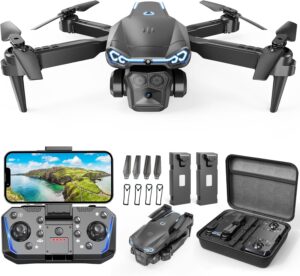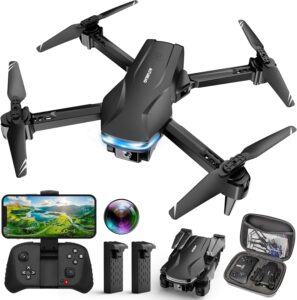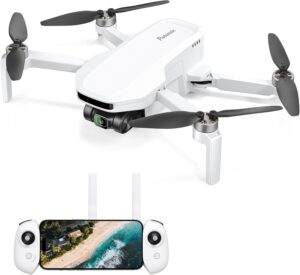Is it possible that a featherweight FPV camera could make us braver pilots without turning our living room into a boneyard of broken succulents?
BETAFPV C03 FPV Micro Camera Review: Tiny Camera, Big Confidence
We strapped the BETAFPV C03 onto our micro whoops and asked it to perform the oldest magic trick in the FPV book: help us see more than we deserve to see. With its 1/3″ CMOS sensor, Global WDR, 1200TVL resolution, 2.1mm lens, and a featherlight 1.52-gram body, this little camera promises clarity and calm where our thumbs tend to add chaos. It also claims plug-and-play ease thanks to a JST-0.8 connector, which is the FPV equivalent of a zip tie for the soul.
We’ll say it upfront: we liked it. Not because it transformed us into ace pilots, but because it made us feel like we might be one day, on a good Tuesday, with enough battery packs and a merciful sun.
BETAFPV C03 FPV Micro Camera 1/3'' CMOS Sensor 1200TVL with Global WDR 2.1mm Lens 160° FOV NTSC 4:3 for Indoor Micro Whoop Drone Quadcopter Like Meteor Series Drones and BETAFPV Micro Canopy
Key Specifications at a Glance
We put the essentials in one place because we, too, have rummaged through product pages like raccoons.
| Feature | Detail |
|---|---|
| Sensor | 1/3″ CMOS |
| Resolution | 1200TVL (analog) |
| Dynamic Range | Global WDR |
| Lens | 2.1mm |
| Field of View | 160° (wide) |
| Aspect Ratio | 4:3 |
| Video System | NTSC |
| Weight | 1.52 g |
| Connector | JST-0.8 plug (no soldering) |
| Compatibility | BETAFPV M03 VTX, Meteor series whoops, most micro whoops, BETAFPV F4 1S 5A AIO Flight Controller, NBD BeeBrain FC |
| Material | ABS housing; recommended with BETAFPV micro canopy |
In short, it’s built to fit small frames, keep weight off, and show a lot of the world without turning it into a fisheye carnival.
Design and Build: Small Enough to Forget, Strong Enough to Trust
We expected an ultra-light camera to feel delicate, like a leaf that might sigh and shatter if we looked at it too hard. Instead, the C03 gives off a tidy, sturdy vibe, the kind that suggests a personality: modest, but willing to tackle a wall corner at 20 mph under a micro canopy without writing a bitter memoir about it.
Made from ABS and meant to nest neatly inside the BETAFPV micro canopy, the camera slots into the whoop ecosystem like it was always part of the family. We appreciate the functional simplicity: no ornamental whiskers, no mysterious calibration wheels waiting to be bumped.
Weight Matters on Whoops: The 1.52 g Advantage
We’ve flown heavier cameras on 65–85 mm frames, and we’ve felt it. A gram here or there turns into lost agility, upset PIDs, and a motor that sounds like it needs coffee. At 1.52 g, the C03 pulls its weight—in that it barely does. Throttle feels livelier, tiny maneuvers get tighter, and battery life edges a little longer. It’s the kind of difference you notice only after you put an older, heavier unit back on and wonder why your drone suddenly seems to have opinions.
Lens and FOV: 2.1mm for Rooms That Suddenly Feel Bigger
A 160° field of view is generous without going full fishbowl. We can still tell where the couch ends and the cat begins, and straight lines don’t bend into slapstick. The 2.1mm lens captures a spacious, situational awareness-friendly image that helps us corner better in tight indoor spaces. For tiny whoops, that wide angle is not a luxury—it’s survival with dignity.
Image Quality: What 1200TVL and Global WDR Look Like in Real Flying
What does 1200TVL mean in practice? It’s analog, so we’re not pixel-peeping; we’re impression-peeping. The C03’s picture is crisp enough to spot the threads on your old carpet, provided your VTX and goggles are up to the task and your band isn’t full of neighbors trying to fly at the same time. Where it stands out is the Global WDR, which keeps bright windows from exploding into white glare while keeping dim corners visible.
Colors land somewhere between realistic and flattering. Greens show up as green rather than green-with-issues. Skin tones don’t go orange or ghostly. Most importantly, highlights and shadows coexist without a familial feud. Transitions from light to dark feel even, which is our main test for micro whoop cameras: can we zip from the kitchen to the sunlit hallway without slamming into the moral equivalent of a photograph from the mid-1990s?
Low-Light Performance: Chasing Dust Bunnies at Dusk
We took it out during that weird hour when the sun gives up its job and the lamps haven’t started theirs. The C03 stayed composed. There’s some noise—of course there is with analog and small sensors—but detail remains workable and movement stays interpretable. The WDR saves us in shadowy corners, and we didn’t get the sort of smearing that makes a lamp look like an alien visitation. If your style of flying involves tiny orbits around houseplants after sunset, this camera won’t scold you for it.
4:3 NTSC: Why Aspect Ratio Still Matters
The C03 runs 4:3 NTSC, which is the human shoulder-width of FPV formats. It’s the most natural fit for flying micro whoops because we care about vertical FOV—seeing the ground and the ceiling is more important than left-and-right drama. If your goggles or displays are 16:9-biased, you’ll see some cropping or stretching, but in a whoop world, 4:3 is the practical choice. We get more sky for chases and more floor for landings-that-are-actually-crashes.
Setup and Installation: Plug the JST-0.8 and Call It a Day
We’ve done our time with tiny pads, soldering irons, and the quiet despair of a lifted trace. The C03’s JST-0.8 plug is a small mercy. Pair it with an M03 VTX, a BETAFPV F4 1S 5A AIO, or a BeeBrain, and you’re up and running in minutes. If you can align connectors and not lose your canopy screws in a shag rug, you’ve got this.
Installation looked like this for us:
- Seat the C03 in the BETAFPV micro canopy.
- Plug the camera into the FC or VTX using the JST-0.8 lead.
- Route the wire so it won’t tango with props or the frame.
- Mount the canopy, double-check lens alignment, and test video feed before your inaugural crash.
No solder, no ceremony, and no existential questions about polarity. We still checked the manual because we are not brave enough to skip it, but the process never questioned our life choices.
Compatibility Notes: Meteor Series and Most Micro Whoops
It’s built with the Meteor series in mind, and it shows. On Meteor frames, canopy fit is just right, and camera angle stays where we set it. We also had an easy time on other micro whoop frames that accept nano-style cameras with canopies. The BeeBrain FC and BETAFPV F4 1S AIO are explicitly compatible, and we had no fuss with the M03 VTX. As always, pay attention to connector pinout—video always wants its particular friend.
In the Air: How It Feels to Fly With the C03
Analog cameras are about feel more than math. The C03 feels responsive, consistent, and forgiving. We never found ourselves guessing what was in front of us. Latency is effectively immediate by analog standards; we didn’t notice any lag that prevented tight lines or reactive stick work.
Flying through doorways, under chairs, and around suspicious floor lamps felt manageable. The WDR helped especially when we crossed boundaries—shadowy hallway to bright window, for example—without turning the brighter scene into blinding drama. The image stays stable enough that we didn’t feel punished for trying to be ambitious.
Indoor Flying: Kitchens, Hallways, and the Plant We Swear Wasn’t There
Indoor whooping thrives on cameras that can roll with changing light and low ceilings. The C03’s wide FOV and WDR shine here. LEDs don’t buzz into bands, shiny countertops don’t erupt into glare, and the camera angle sits steady, which we only notice when it doesn’t. We clipped a branch at eye level, and the lens shrugged it off with nothing but a smudge we wiped with the corner of a T-shirt we promised to wash later.
Outdoor Flying: Gentle Breezes and Parking Lots
Outside, the camera holds its own. On gray days, textures read nicely. On bright days, WDR keeps highlights from going nuclear. It’s not a long-range camera, and we never pretended it was; this is for proximity and micro flow. Parking lot meanders and backyard slaloms felt right. Distant detail is limited, as you’d expect on analog, but near-field clarity is where this camera lives, and it lives well.
Durability: The ABS Kind of Resilience
We’re realists. If we can’t fly like champions, we can crash like them. The ABS housing with the recommended BETAFPV micro canopy makes the C03 surprisingly sturdy for its gram count. The lens sits a little back from the canopy edge, which helps it avoid direct hits. After several unplanned landings, we saw no cracks, no loosened connectors, and no drifting focus. Wipe the lens, re-seat the canopy, keep flying.
The JST-0.8 connector also held up. We unplugged and replugged more times than necessary in the name of curiosity, and the connection stayed snug without feeling brittle. It’s a small detail until it isn’t.
Video and OSD: What You See, Plus Whatever Your FC Adds
The C03 presents a clean analog feed that plays nicely with flight controller OSD overlays. Battery voltage, RSSI, timers—everything we piped through showed up crisply enough to read at a glance. We didn’t adjust any in-camera settings via a joystick-style menu; the experience felt like a set-and-fly camera. For us, that worked. This category is about getting airborne quickly and seeing clearly, not about fiddling like we’re tuning a radio from 1964.
Who It’s For: Micro Whoop Pilots Who Value Clarity and Weight Savings
If you fly indoor whoops, care about weight, and prefer a wide, stable image with good dynamic range, this camera fits like a good habit. Beginners gain confidence from its predictability and plug-and-play setup. Experienced pilots will appreciate the WDR and wide FOV in tight environments, along with the extra headroom that comes from saving a gram or three on the nose.
It’s particularly strong for:
- Meteor series owners who want a factory-friendly match
- Pilots upgrading from older 600–800TVL cameras
- Builders who hate soldering on Tuesdays and every other day
- Folks who need a reliable analog 4:3 feed for indoor practice tracks
Who It Isn’t For
If you’re married to 16:9, or you want PAL, this camera won’t become something it isn’t. And if your heart is set on digital HD with on-screen menus and tweakable profiles, the C03 isn’t pretending to join that conversation. It’s an analog specialist for micro frames, and it knows its job.
Pairing It Right: VTX, Canopy, and Goggles
The camera’s best friend is the BETAFPV M03 VTX. Together, they make a neat, lightweight package with wiring that respects our time and sanity. We also had an easier time with the official BETAFPV micro canopy than with generic housings; it aligns the lens and protects the camera without weighing down the front.
For goggles, anything that treats 4:3 NTSC with warmth works well. If you run a 16:9 display, watch for cropping or set your goggles to 4:3 to keep vertical view intact. This is a flying experience that rewards seeing up-and-down more than left-and-right.
Comparisons: How the C03 Stacks Up in the Whoop Universe
We’ve flown a handful of micro cameras that occupy similar niches. Older analog units with 600–800TVL simply don’t offer the same clarity or dynamic range. Lines look softer, and transitions from indoor to sunlit spaces get blotchy. Heavier nano cameras (14×14 mm class) might look comparable in some conditions, but the weight penalty shows up in the flying—especially on 65–75 mm frames.
Compared to typical budget micro cams that skip WDR or rely on basic dynamic range, the C03’s Global WDR makes the difference between a passable flight and a repeat attempt. We’ve flown cheap cameras that turn windows into ghost portals; the C03 keeps the room and the window in the same reality.
No, it’s not digital, and no, it won’t produce DVR footage that wins cinematic awards. But it will make you feel sure-footed inside doorways, and sometimes that’s the whole game.
Tips and Tricks for Getting the Best Image
We don’t want to micromanage your flying, but we’ve picked up a few habits that kept things looking sharp.
- Align the canopy carefully. A tiny tilt becomes a nagging horizon drift you’ll blame on gravity.
- Keep the lens clean. Fingerprints turn every light into a smear of regret. Use a microfiber cloth or the softest corner of your shirt if you must.
- Secure the wire harness. A loose lead will eventually meet a prop, and the prop will win.
- Match your goggles’ aspect ratio. Set them to 4:3 for the intended view.
- Check focus after a crash. The lens is usually locked and stable, but we still glance to make sure nothing shifted.
- Use the recommended canopy. It fits right and adds protection with minimal weight.
- Avoid excessive VTX power indoors. Overpowered signals can create interference; balance clarity with courtesy to your neighbors and your own receiver.
Troubleshooting: If Things Go Sideways
Analog is forgiving, but it likes a few ground rules. When the video gremlins strike, we go down this list:
-
No video feed at all
- Check the JST-0.8 connection and that it’s fully seated.
- Confirm the VTX camera input is correct and that the VTX is powered.
- Verify you’re tuned to the right channel and band on your goggles.
- Make sure the FC or VTX is actually receiving power.
-
Rolling lines or unstable image
- Ensure proper grounding; the camera and VTX should share ground.
- Lower VTX power indoors if you’re getting multipath interference.
- Check for noise from motors or ESCs; route the camera wire away from power leads.
-
Blown-out highlights or crushed shadows
- Angle the camera slightly downward to reduce sky dominance outdoors.
- Clean the lens; haze amplifies highlight glare.
- If your VTX has image settings, reset them to defaults.
-
Jello or vibrations
- Inspect props for bends, hair, or other indignities.
- Make sure the canopy isn’t overtightened; tiny harmonic changes affect micro frames.
- Replace tired motors; whoops are honest about their feelings.
-
OSD missing
- Confirm the flight controller’s OSD output is active.
- Ensure the video wire goes through the FC if you’re using FC OSD overlay.
Frequently Asked Questions
-
Does it support PAL?
- It’s NTSC 4:3. If you need PAL, this isn’t the match.
-
Will it fit Meteor series whoops?
- Yes. It’s designed to pair well with Meteor frames and the BETAFPV micro canopy.
-
Does it require soldering?
- No. The JST-0.8 connector makes it plug-and-play with compatible VTXs/FCs like the M03 VTX, BETAFPV F4 1S 5A AIO, and NBD BeeBrain FC.
-
Is there a microphone?
- We treat it as a video-focused camera. If you need audio, look to your VTX or other dedicated solutions.
-
Can we adjust settings like in some menu-driven cameras?
- We flew it as a set-and-fly unit. The selling point here is simplicity and reliable WDR out of the box.
-
Is the lens replaceable?
- It’s a compact micro unit; lens swaps aren’t the usual path. We kept ours stock and were happy with focus and field of view.
-
Will it survive crashes?
- With the recommended micro canopy and a little luck, yes. We logged our share of rough landings and kept flying.
Safety and Power Notes
We always check polarity twice and plug once. The camera connects to the VTX or FC via JST-0.8; verify the pinout on your specific board or VTX before powering up. Running the camera through the FC also simplifies OSD overlay. If you’re unsure, check the wiring diagram from your FC/VTX manual—the camera wants video signal, ground, and appropriate power from the system’s dedicated camera feed.
Keep wires away from props, and don’t pull on the camera lead when removing the canopy. The connector is sturdy, but none of us are as gentle as we claim to be.
Real-World Use: Little Things We Noticed That Mattered
- The camera angle stayed put across hard knocks. We set it once, and it never slumped into “perpetual horizon-watching” mode.
- Reflection handling on glossy surfaces was kinder than we expected. Kitchen granite didn’t bloom into a cosmic event.
- The field of view made split-S maneuvers in tiny rooms slightly less ridiculous. Not elegant, exactly, but possible.
- Our crashes taught us that the canopy is the hero no one talks about. Don’t skip it.
- On the days we felt rusty, the C03 didn’t punish us with unforgiving contrast. It showed what we needed without drama.
The Long-Term Angle: How It Fits Into a Whoop Fleet
Micro whoops multiply like thoughts at 2 a.m. One for indoors, one for the backyard, one for the friend who said they’d never fly and then asked about battery chargers. The C03 is the kind of unit we’d standardize across a few builds because it removes variables. When all the cameras feel consistent, our muscle memory stops arguing with our eyes.
Since it’s plug-and-play, swapping parts after a crash feels less like penance. We keep a spare in the parts bin because fortune favors the prepared, and also because tiny screws have a way of launching themselves into alternate dimensions.
A Quick Comparison Table for Decision-Makers
If you’re still weighing whether this fits your build, this snapshot sums up the practical tradeoffs.
| Consideration | BETAFPV C03 Experience |
|---|---|
| Weight | Excellent for 65–85 mm whoops at 1.52 g |
| Ease of Install | High, thanks to JST-0.8 plug and canopy fit |
| Image Clarity | Crisp analog with 1200TVL; stable colors |
| Dynamic Range | Strong; Global WDR handles bright/dark transitions |
| Aspect Ratio | 4:3 NTSC; ideal for micro flying and vertical awareness |
| Durability | Good with recommended canopy; lens sits well-protected |
| Indoor Performance | Very good; wide FOV and WDR shine |
| Outdoor Performance | Solid for proximity and short-range analog |
| Tinker Factor | Low; it’s a set-it-and-fly unit |
| Best Pairings | BETAFPV M03 VTX, BETAFPV micro canopy, Meteor frames |
Pros and Cons in Plain Words
We don’t need needless nuance. Here’s how it feels after real use.
Pros:
- Light enough to matter on micro frames
- Global WDR that actually helps with windows, lamps, and outdoor glare
- 2.1mm lens with 160° FOV that feels spacious without warping the world
- NTSC 4:3 for whoops that need vertical awareness
- Plug-and-play connector, no soldering for compatible setups
- Built tough for its size, especially with the recommended canopy
- Friendly to FC OSD overlays with minimal fuss
Cons:
- NTSC-only and 4:3 means no PAL and no 16:9 option
- Analog won’t satisfy pilots set on digital HD
- Minimal adjustability; what you see is what you get
- Best results tied to compatible canopies and VTXs
Why We’d Recommend It
We’d recommend the BETAFPV C03 to anyone building or refreshing a micro whoop that lives primarily indoors and pops outside for short, joyful errands. It hits the sweet spot of clarity, dynamic range, weight, and convenience. The wiring is simple, the image is easy to trust, and our brain can spend more time thinking about lines and less about whether we’ll be squinting through glare.
It’s a practical choice with a little style: the kind of camera that makes us feel like we’ve grown as pilots when what we’ve actually done is choose a tool that lets us see better.
What Surprised Us Most
We expected the WDR to be good; we didn’t expect it to be this smooth in mixed lighting. We expected the plug-and-play to work; we didn’t expect to enjoy it this much. The surprise is how it lifted the whole experience without any particular fuss. We flew more because we weren’t fiddling, and the more we flew, the better it felt.
Maintenance: Keeping It Sharp Over Time
We’re creatures of habit, so we built a small routine around the C03:
- After rough flights, glance at the lens for smudges or micro-scratches. A gentle wipe fixes most things.
- Check that the canopy screws are snug but not torqued. Over-tightening introduces micro vibrations.
- Make sure the JST connector hasn’t started to back out after impacts. It rarely does, but peace of mind matters.
- If the image suddenly looks off, backtrack through recent changes: new VTX settings, a crash, or a cable that got pinched when we rushed a canopy.
Good habits with tiny gear pay off like compound interest, but without the spreadsheets.
The Emotional Part: Why This Camera Makes Flying Fun Again
We went through a phase where building felt like admin. The C03 helped reverse that. We could swap it in quickly, and we could count on the image. Suddenly, we were practicing gates in the hallway instead of reorganizing our parts bin. The difference between a half-hour of test flights and a half-hour of real flying is what keeps us coming back.
There’s also something endearing about gear that under-promises and over-delivers. The C03 doesn’t claim to turn us into champions. It just gives us a clean, wide, stable window to the world, and that’s enough to make us a little braver.
Bottom Line Value
If we wanted the least effort for the most clarity in a micro analog setup, we’d pick this. The combination of 1200TVL, Global WDR, and true plug-and-play in a 1.52-gram package is a recipe for many, many Lipo cycles of practice and casual joy. For indoor whoop enthusiasts, it’s an easy yes. For backyard bashers and parking-lot poets, it’s a solid partner.
Final Thoughts: The Tiny Camera That Nudges Us Forward
We measure flying gear by how often it gets in our way. The BETAFPV C03 rarely does. It’s light, it’s clear, it’s wide, and it’s friendly to build with. It’s also unpretentious. The real compliment is that after a few flights, we stopped thinking about the camera at all. We just flew.
If you’re building a Meteor series whoop or outfitting any micro frame that values gram-count and crisp analog video, this little unit deserves a spot. It won’t write poetry for you, but it will make the living room feel like a track and the hallway feel conquerable, even on days when the cat’s patience is thin. That, for us, is reason enough to keep it in the fleet.
Disclosure: As an Amazon Associate, I earn from qualifying purchases.
